Great from the start…
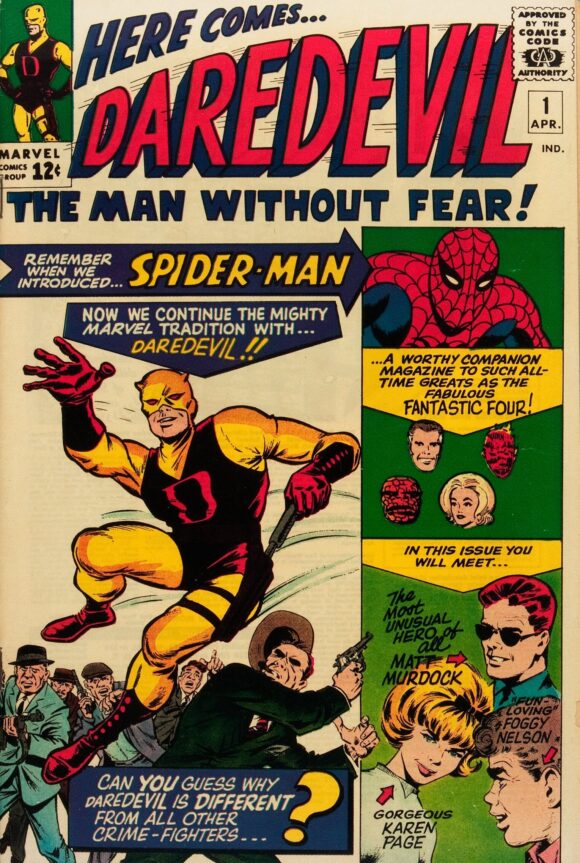
Cover pencils by Jack Kirby and Bill Everett, with inks by Dick Ayers and Everett
By PETER BOSCH
It was February 4, 1964, and there on the newsstand was a bright new cover featuring the first appearance of Daredevil, a hero that Marvel said was as important as Spider-Man and the Fantastic Four. And the inside splash page promised “this magazine is certain to be one of your most valued comic mag possessions in the months to come.” And they were right. But “months”? Heck, decades to come.
It is now the 60th anniversary of that issue and here are 13 INGREDIENTS THAT MADE DAREDEVIL A STAR:
—
1. Daredevil’s Introduction. DD makes his very first appearance inside a gym of tough professional fighters in the employ of the Fixer and defeats them without breaking a sweat. (Note Stan Lee’s deliberate omission of any thought balloons by Daredevil so the reader won’t know yet of his secret.)
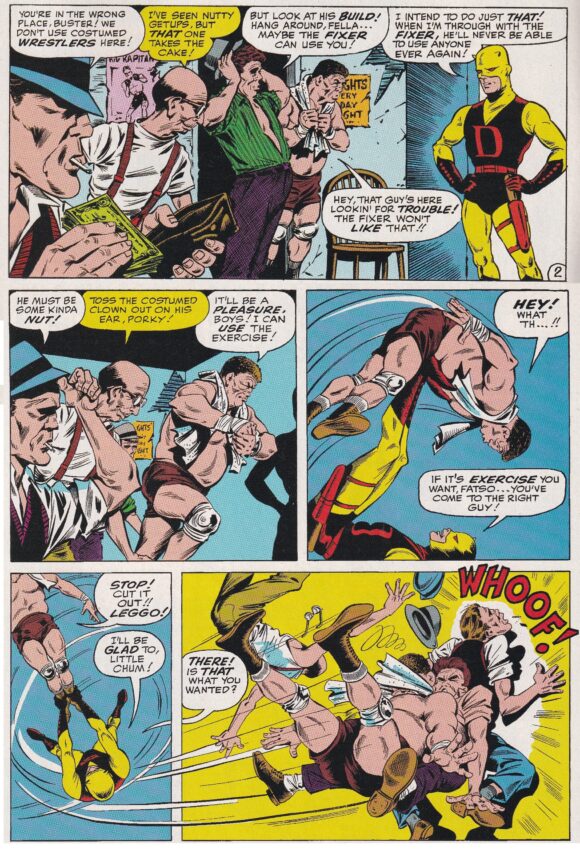
Daredevil #1. Script by Stan Lee, art by Bill Everett
—
2. Jack Murdock. Matt’s father, Jack Murdock (aka “Battling Murdock” aka “Kid Murdock”) was the one who told Matt to “study every chance he got” in lieu of playing baseball with other neighborhood kids, because he wanted him to have a better life than his old man.

Daredevil #1
—
3. Heroism. Matt Murdock was a hero before he became Daredevil. His rush into danger to save the old man, without a thought for his own safety, is what being a hero is all about.

Daredevil #1
—
4. “Battling” Murdock’s Last Fight. Jack Murdock may have been a boxer down on his luck, but he was a father first and he was determined to win the fight for Matt… even though he likely knew he was marked for death by the Fixer for going against his orders to take a dive. (If you would like to see how that fight could have looked on the silver screen, watch the final bout at the end of the 1949 movie The Set-Up. There are similarities with actor Robert Ryan as a washed-up pug who refuses to take a dive — and his fate afterward by the fixer of the fight.)
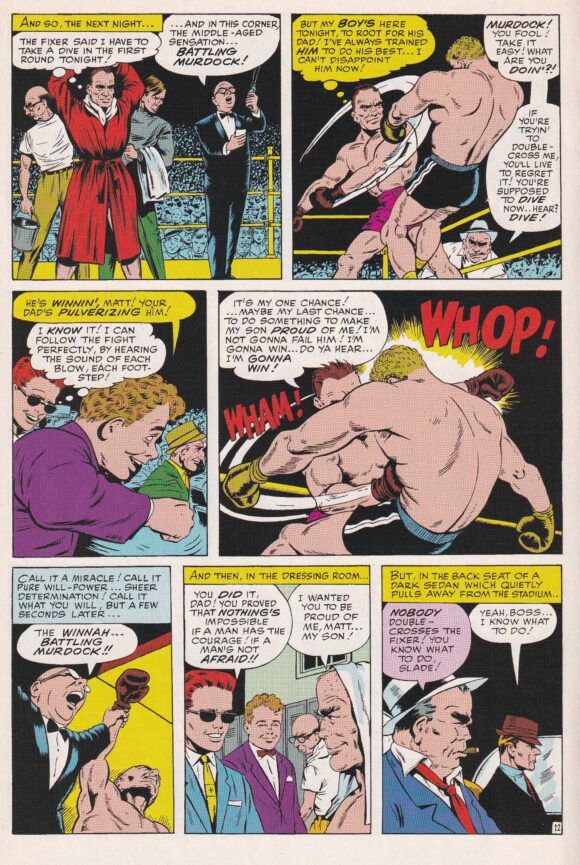
Daredevil #1
—
5. The Costume and Name. Before Matt could bring the Fixer and his henchman to justice, he had to find a solution to the promise he made to his father years before, that he would not become a fighter.
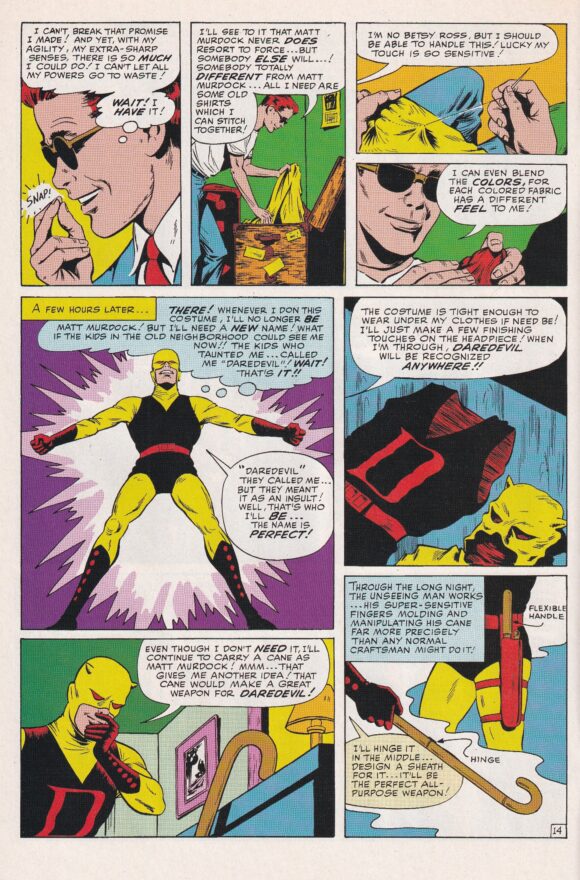
Daredevil #1
—
6. Foggy Nelson and Karen Page. The only other cast members in the early days of the series were Foggy Nelson, his law partner, and Karen Page, their secretary, and their loyalty to Matt was second to none — except Foggy was always jealous that Karen favored Matt over him when it came to feelings of love.

Daredevil Annual #1 (1967). Script by Lee, pencils by Gene Colan and inks by John Tartaglione.
—
7. The Purple Man. The most blasé-looking of all villains, the Purple Man (aka Kilgrave) was just that… a man all in purple who was quickly dispatched in Daredevil #4. Who could have imagined he would become one of the greatest menaces in Marveldom? His ability to mentally control anyone into doing anything was the focus of a critically acclaimed arc in Alias, the comics series that gave us Jessica Jones. That arc was adapted into the first season of the Netflix show Jessica Jones, with Jessica (Krysten Ritter) terrified of becoming his mental slave again. David Tennant, perhaps best known as the 10th and 14th Doctors in Doctor Who, played Kilgrave.
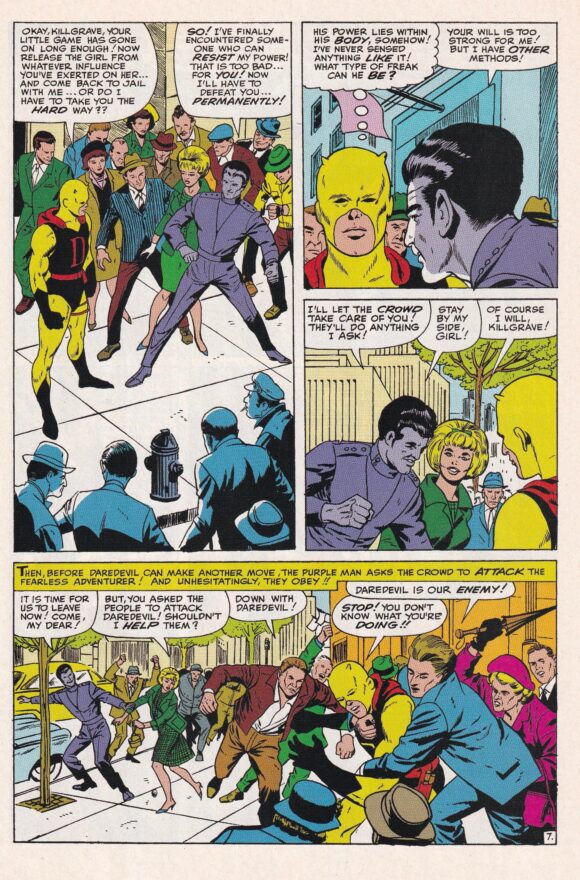
Daredevil #4 (1964). Script by Lee, pencils by Joe Orlando and inks by Vince Colletta.
—
8. Stan Lee. Lee was turning out so many scripts in those glory days of early Marvel that it is surprising they could all be as entertaining as they were, but they were! Especially Daredevil.
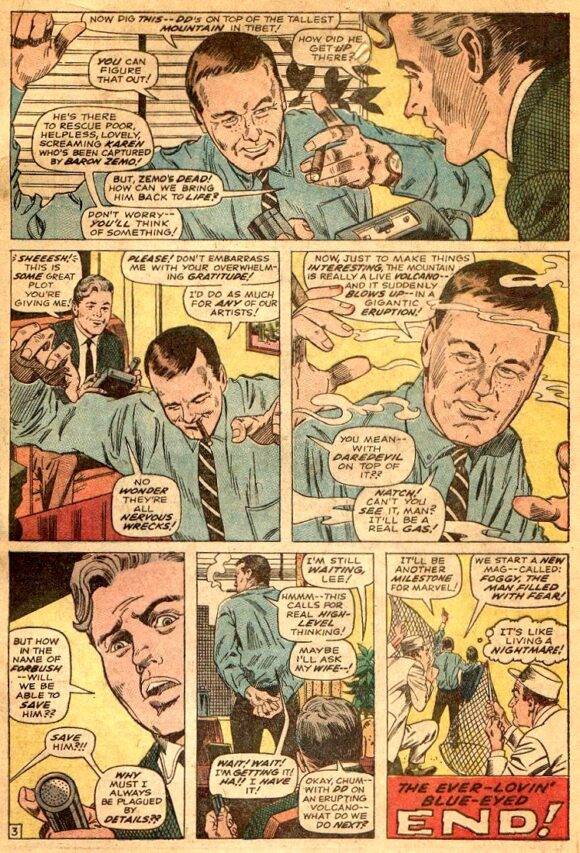
Daredevil Annual #1. Script by Lee, pencils by Colan and inks by Tartaglione.
—
9. Bill Everett. Bill Everett only drew the first issue but he was an excellent choice for the series introduction. There were no fantastic sets to illustrate, just an ordinary gym on New York’s Lower East Side, street scenes, Hell’s Kitchen, and a subway stop. Everett kept Matt Murdock and Daredevil anchored in reality and that made that first story different from others.
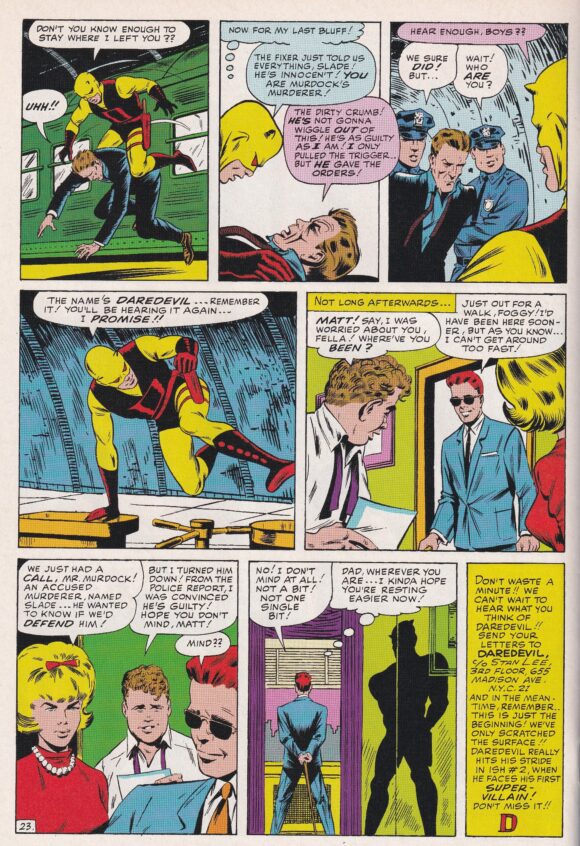
Daredevil #1
—
10. Wallace Wood. Following Bill Everett’s single issue, the title was drawn for three issues by Joe Orlando, and then turned over to Wallace Wood with #5 (Dec. 1964), with the splash page of that issue saying he was to become the permanent artist for the series. One of his accomplishments was to redesign DD’s costume, turning it a solid red, more in line with the devil theme. However, Wood’s time on the strip was fated to come to an end with the 11th issue (Dec. 1965). It was already apparent a change was about to occur when #10 had layouts by Bob Powell and #11 was pencilled by Powell, with just inks by Wood. But, oh, what incredible artwork Wood brought during his time on the series.
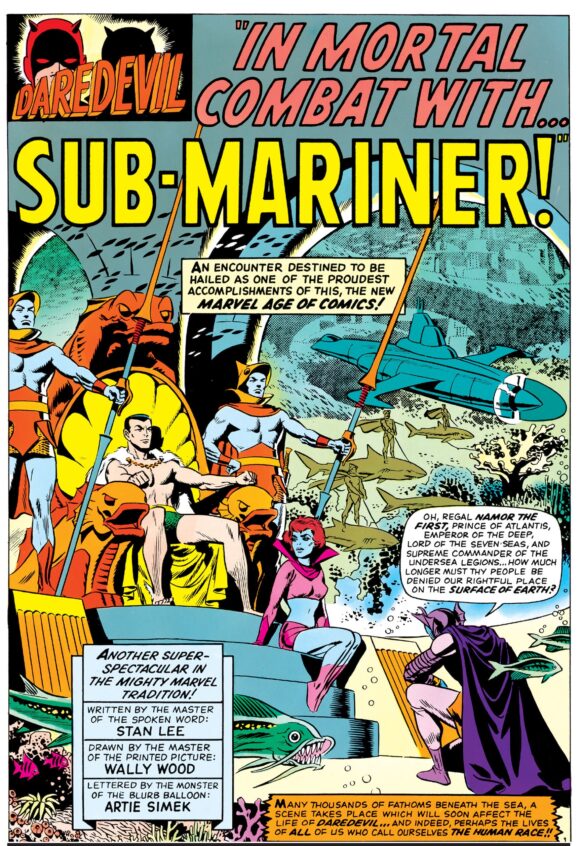
Daredevil #7 (1965). Splash page script by Lee, with art by Wallace Wood.
—
11. Daredevil #7. Not only the best of the early issues, but a true classic in the entire history of comic books. Daredevil #7 (Apr. 1965) was written by Lee and majestically drawn by Wood with one of the noblest endings to any comic story.
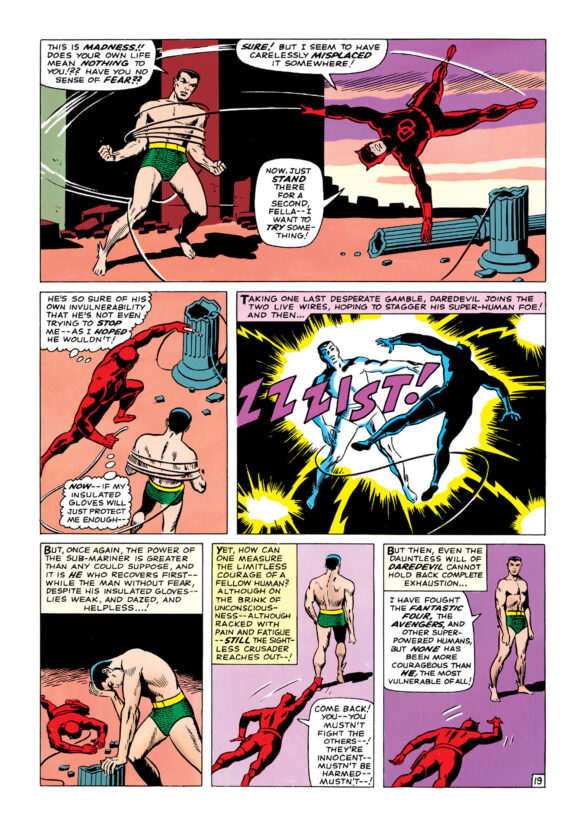
Daredevil #7
—
12. Steve Ditko. While Daredevil was still in his yellow-and-red costume period, he guested in The Amazing Spider-Man #16 (Sept. 1964), giving Steve Ditko a chance to draw Marvel’s newest hero. The tale featured Matt going to a circus with Foggy and Karen, which meant that out of all the circuses in the world – this being Marvel comics – it would have to feature the Circus of Crime (previously seen in The Incredible Hulk #3, September 1962), led by the villainous Ringmaster. When Ringmaster uses his gimmicked top hat to hypnotize the audience and Spider-Man, Matt is unaffected because he cannot see it. He changes into Daredevil and has to fight Spider-Man to get to Ringmaster, which meant several pages of great Ditko battle scenes.

Steve Ditko cover art
—
13. Gene Colan. Issues #12 through #19 were drawn by John Romita — including #16 and #17 with guest appearances by Spider-Man — who was cutting his teeth on superhero comics. With the coming of Daredevil #20 (Sept. 1966), the splash page announced that Romita was working on another assignment (Spidey) and Gene Colan would fill in for that issue. Colan’s “fill-in” was actually the start of a 78-issue run on the title through #100 (June 1973), missing only three issues during that time. Marvel had finally found the perfect artist for the book. Under Colan’s pencil, Daredevil bounded everywhere, soared in the sky (with the aid of his billy club), twisted and rolled, and all in a perfect form that any Olympic gymnast would envy. Colan’s work was cinematically spectacular, and years of drawing romance comics added great dimension to Matt’s relationship with Karen.

Daredevil Annual #1. Script by Lee, pencils by Colan and inks by Tartaglione.
—
And just for kicks, here is Colan having fun with Daredevil, from 1967’s Not Brand Echh #4:

Script by Lee, pencils by Colan and inks by Tartaglione.
—
MORE
— DAREDEVIL #8: Dig This Wonderful Upcoming ‘Hidden Gem’ Variant Cover by JOHN ROMITA. Click here.
— MARVEL to Release FEBRUARY 1964 OMNIBUS to Mark DAREDEVIL’s Anniversary. Click here.
—
13th Dimension contributor-at-large PETER BOSCH’s first book, American TV Comic Books: 1940s-1980s – From the Small Screen to the Printed Page, was published by TwoMorrows. He is currently at work on a sequel, about movie comics. Peter has written articles and conducted celebrity interviews for various magazines and newspapers. He lives in Hollywood.
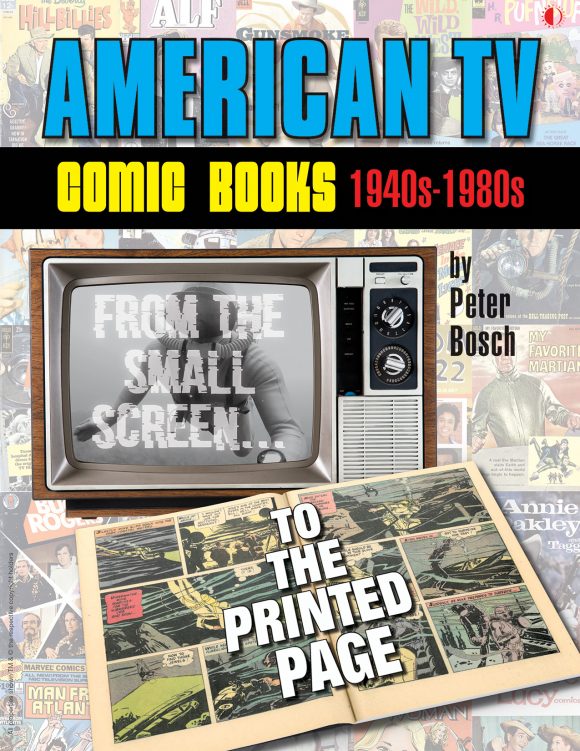

February 4, 2024
Geez, D.D. is 60 ?! Wow.
Lots of great artists drawing his adventures.
Hopefully IDW will do a Gene Colan Daredevil artists edition some day soon.
February 4, 2024
I love early Daredevil and in honour of his 60th birthday I’ll have to give my run of issues 1 to 60 a look through.
February 4, 2024
Happy 60th birthday to the “Daredevil” brand!
February 5, 2024
Wonderful! I’ve read some of the earlier stories and I’m the odd man out in liking the black and yellow outfit over the devilish red one! And I agree with your opinion on Everett’s artwork in that first story; look at that last panel—it’s as happy an ending as that story could get, and that shadow on the wall; look closely…is that Daredevil with his holster or is that a certain boxer in his boxing shorts? Either way it’s cool!
February 5, 2024
I am also a fan of the original costume and colors. It fits the era under which it was created. I didn’t hate the red but just enjoyed the classic original look.
I was never a fan how Frank Miller made his name, character about a troubling reconciling of his Catholic faith. That and ninjas, and, I all but stopped buying DD’s issues.
Gene was definitely my favorite on the character.
February 8, 2024
There are really only two reasons why DD is a star: Gene Conan and Frank Miller.